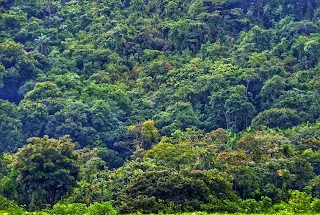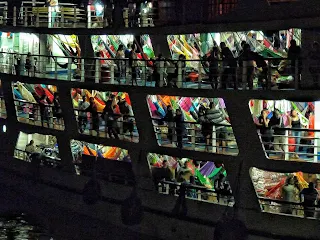046 BRAZIL - PART THREE
The Amazon River - Belem to Manaus by boat
28 December 2011 - 8 January 2012
MAP
PHOTOS
E-BOOK
26-27
December – Belem
The
Amazon has two seasons: rainy and dry. This was the rainy season and we could
expect daily rain. Belem also marked the end of Amanda’s cycle trip. From
Belem, the plan was to take a boat along the Amazon River to Manaus, from where
she planned on returning to South Africa. Belem turned out not as wild-west as
expected. The town was relatively modern, revealing lovely parks and a
population of 1.5 million. From Belem, the view of the Amazon River was
unimpressive: simply a vast muddy river.
I
headed straight to the busy port and market to see if they sold anything of
interest. The market had more than enough herbs to cure any ailment.
We
relocated to the hostel after a two-day stay in our upmarket hotel. The hostel
was an old rubber baron mansion: a stunning place offering lovely wooden
floors, four-metre-high ceilings and crystal chandeliers.
I
was excited as this was the day we bought our boat tickets to Manaus on the
Amazon River. Tickets came in a wide price range, depending on the vessel.
Taking into account Amanda’s fear of water, we chose a large and stable boat. Researching
our boat online, Amanda thought it best to find something more substantial. By
morning we thus headed to the boat office and upgraded our tickets to a larger
vessel.
THE
AMAZON RIVER
BELEM
– MANAUS - BY BOAT
28
December - Belem - Manaus - By boat - Day 1
On
28 December, we headed to the port where the Rondondin, our home for the next
six days, lay waiting. I boarded nervously, not knowing how my sister would
handle the trip. She did, however, appear entirely at ease on the larger boat,
which felt more stable. We booked a cabin instead of hammocks, as Amanda
claimed she couldn’t get in and out of a hammock, let alone sleep in one for
five nights. Sleeping in a hammock sounded romantic but I agreed that five
nights might be a tad too much.
Once
settled, the canteen provided cold beer and food. At the same time, our boat
sailed into the sunset, leaving Belem in the distance. Our first evening on the
mighty Amazon came with a stunning sunset. The cabin turned out a noisy affair and
it felt like we were right next to the engine room. Most of our time was thus
spent on the deck.
Day
2
On
waking, our boat was manoeuvring up a narrow channel thick with lush vegetation
on both sides. Here villagers rowed to the boat to collect what people threw
overboard, it seemed passengers brought bags of clothing for this purpose. Each
item was tightly wrapped in a plastic bag and then dropped overboard for villagers
to collect.
All
day people continued rowing towards the boat as the ship sailed close to the
riverbank. If they were fast enough, they could latch their canoes onto the
boat, get on and sell their wares (mostly cooked shrimp). Everyone on board
supported them, and the shrimp were shared for all to enjoy. At one stage, our boat
slowed, a canoe latched on and offloaded homemade juice. The Brazilians are
such an accommodating bunch.
It
wasn’t long before thick clouds gathered and rain bucketed down. The storm
ended equally quickly, revealing a spectacular sunset over the Amazon jungle.
At 20h00 our boat anchored at Gurupa, where more passengers waited. The
quayside resembled the boarding of the Ark, and we couldn’t believe that people
had that many possessions in the middle of the jungle.
Capturing
the forest’s density and the Amazon’s vastness on camera was quite impossible.
I tried, but to no avail; well done to those who’ve managed. It’s an
extraordinary area, almost impossible to describe.
Day
3
Our
third day was slightly different as our boat left the narrow channels and
headed to the open water. Still, the riverbanks stayed densely wooded but now
and again opened onto flat grassy land.
Again,
our vessel stopped at small settlements to offload goods, predominantly rice
and beans. Furthermore, the quaysides were hives of activity – I guessed these
drop-offs were most likely the week’s highlight. Again, vendors climbed onboard
selling snacks and fruit, and nearly all supported them and shared what was
purchased.
The
Amazon is a big watery world, and (like in Borneo) it appeared that kids could row
a boat before they could walk. Fellow passengers were exceedingly kind, sharing
their snacks, making the ship feel like a big family. Kids ran about, and
everyone kept an eye on them. The bar fridge in our cabin soon overflowed with
juice, milk, water, and whatever else people wanted to stay cold.
It
was a pleasant surprise to notice that not once did anyone throw anything
overboard but dutifully placed their garbage in the bins provided. By evening, the
sunset was like thunder over the Amazon, birds flew home, and people on board
settled into their hammocks.
The
Amazon is a vast area and the numbers mind-boggling. The river is enormous, and
the forest is thick and dense. Caboclo communities (mixed indigenous and
European) populate the riverbanks without any sign of indigenous tribes.
31
December 2011 - Day 4
At
around 5 in the morning, we woke to a huge commotion. Passengers were getting
ready to disembark at Santarem. Our early rise resulted in our first sighting
of a sunrise over the Amazon. Santarem was quite a large town, for the Amazon,
and much was loaded and offloaded. The Rondondin only departed Santarem at
midday. We didn’t venture into town as Amanda, again, didn’t feel well.
Santarem was situated at the confluence of the brown Amazon River and the dark
Rio Tapajos. The incredible thing is that the two rivers flowed side by side for
quite a distance without mixing.
The
remainder of the day slipped by as our boat putt-putted upriver past various
scenery—sometimes flat, grassy islands and at times thick jungle. Tiny wooden
houses popped out of the forest to remind us that people indeed lived in this
remote part of the world. The river was massive and hid its treasures well.
With
it being the last day of 2011, we drank a few beers in the company of our friendly
fellow passengers but retired before midnight. We woke again a few hours later
as our boat pulled into another small harbour to offload cargo. Anchoring and
casting off brought great excitement as little else happened on board.
1
January 2012 – Day 5
The
first day of 2012 dawned with thick, dark clouds in the distance. As it was still
pretty dark at 7h00, I was unsure if this was due to the cloud cover or if we
had moved west. Breakfast, like every morning, consisted of fruit, coffee,
juice, bread, ham and cheese – a typical Brazilian breakfast.
I
felt slightly disappointed, not because I hadn’t seen any spear-toting tribes
or man-eating piranhas, but because I had failed to get any decent photos.
Instead, they were all hazy or blurry. I tried almost everything, but to no
avail, they stayed blurry and hazy. My second disappointment was our expensive
bottle of ‘champagne’ - specially bought for New Year’s Day, turned out nothing
more than slightly fizzy apple juice. Hahaha!
As
our boat headed deeper into the Amazon, the weather became more humid,
overcast, and windless. Tiny birds settled on the deck railing without as much
as a feather moving in the breeze.
I
was looking forward to sunset as not once did the Amazon produce the same
display. That evening, the sun didn’t set with a bang as on other evenings, but
came with a soft and subtle array of pinkish colours.
Day
6
Again,
we emerged to overcast conditions, and I went to breakfast which Amanda
skipped, as she didn’t feel like (by then) stale bread and soggy watermelon.
By
then, we had settled nicely into the rhythm of eating, drinking, sleeping and
lazing about while gazing over the river and forest. Five days was a long time
to do nothing, and I was ready to get off the boat. We knew it would be our
final day, but no one could tell when we would arrive in Manaus. The staff’s
best estimate was something between three and seven p.m.
Closer
to Manaus, more settlements appeared along the riverbank, making the scenery a
little more interesting.
And
so came to an end our life on the Rondondin, and I thought I would’ve nothing
to say other than, “We were on a boat for five days”. We docked in Manaus at around
5 p.m. in pouring rain, just the thing one would expect in one of the last
wildernesses in the world. We walked our bikes to a hotel and settled in for
the next few days as this marked the end of Amanda’s holiday.
3
January – Manaus
I
became violently ill during the night - no need to go into detail. The boat’s
food was notorious for giving passengers the runs, and I guess I tried my luck
too many times. Finally, I walked to the laundry to hand in our clothes (risky
business in my condition) and returned without incident.
The
world was smaller than I thought as a certain Mr Markwood arrived at our hotel
looking a bit worse for wear. Life without money was clearly not highly
recommended. Still, we squeezed him into our room.
4
January – Manaus
I
felt slightly better in the morning but could still not eat breakfast. Ernest
had no such problem and consumed practically the entire buffet.
Manaus
was strange because it was a big city in the middle of the jungle, sporting
several interesting sights. Still, I didn’t expect to find an opera theatre in
the middle of the jungle, but there it was. Manaus’s famous Teatro Amazonas was
completed in 1896 and constructed by Lisbon engineers, symbolising the rubber
era’s opulence. Built in a neoclassical style, virtually all materials were
imported from Europe i.e., Italian marble, glass, and Scottish cast iron. In
addition, the road outside the theatre was rubberised to reduce the noise of
late-arriving carriages. I was unsure whether I was impressed or disgusted by
this blatant display of European luxury.
At
Manaus, the black water of the Rio Negro and the white water of the Rio
Solimoes met but didn’t mix and flowed side by side for quite a few kilometres.
The reason (from what I understood) was due to a difference in temperature,
velocity and the fact that the Solimoes carried nearly eight times the sediment
per litre as the Negro.
5-8
January – Manaus
Amanda
was also sick, and the two of us barely had the energy to do anything but
sleep. I didn’t expect the stomach bug to last quite as long. In the meantime,
Ernest raided Amanda’s bicycle of all moving parts to fix his neglected bike
and boxed what remained for her flight to South Africa.
In
the meantime, Amanda and I conjured enough energy for an enjoyable meandering
amble around the nearby park. Then, finally, the time came for my sister to fly
home and for me to move along.
My
visa had expired three days previously, and there remained 1,000 kilometres to
the border. There wasn’t much else I could do but take my chances with the
Brazilian authorities hoping they would treat me kindly.



